Back to Page
Amazon Brand Story
New Modules Introduced To The Amazon Brand Story Feature
New Modules Introduced To The Amazon Brand Story Feature
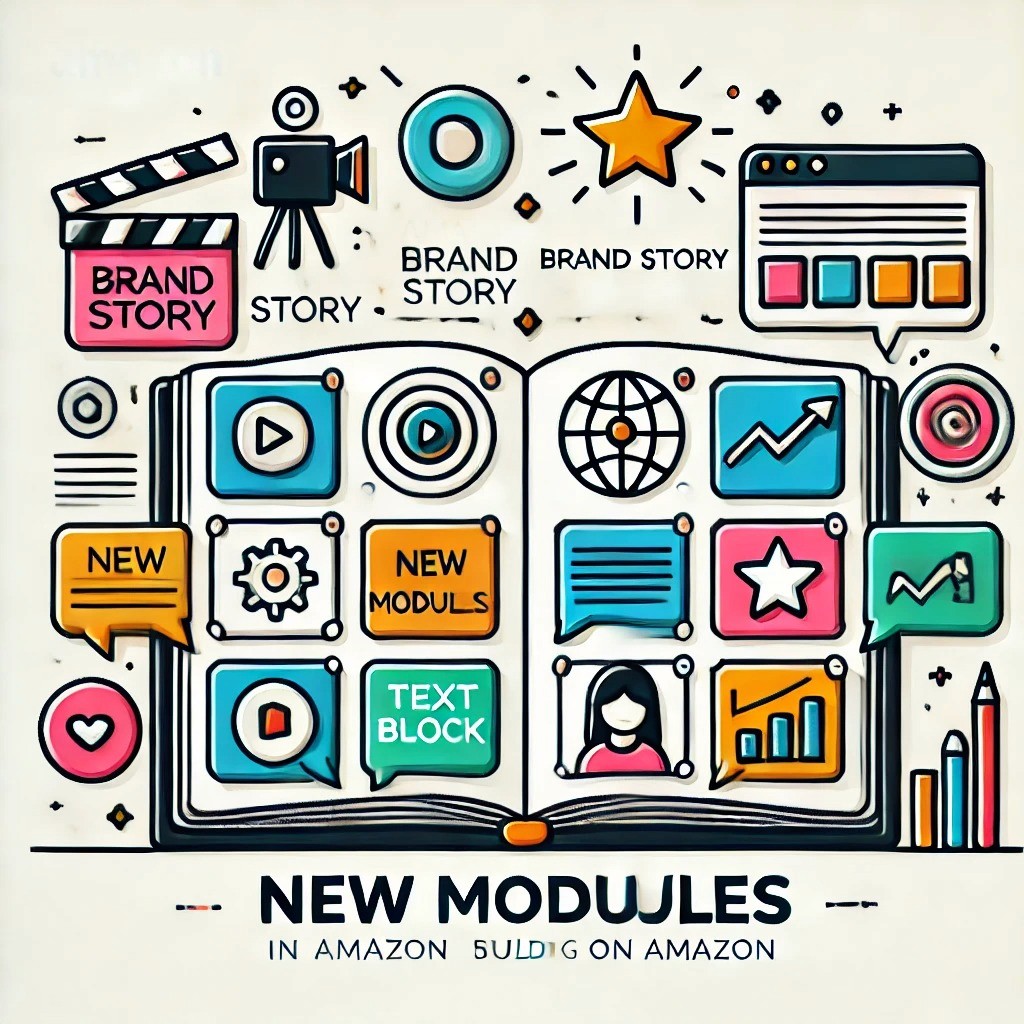

Back to Page
Amazon Brand Story
New Modules Introduced To The Amazon Brand Story Feature

"In the sea of sameness, be unique with Amazon brand story"
Amazon is a crowded marketplace. Sellers spend hundreds of dollars fighting for seconds of attention. Shoppers are bombarded with similar copies, messages, and images every minute of their shopping journey. It is not enough for brands to have a quality product, optimized listing, and competitive price. Everyone has that. One of the key ways to keep your brand on top of customers' minds is by conveying your brand story. Brand story is what differentiates you from the crowd and at the same time makes your brand more relatable and humanized.
In September 2021, Amazon updated its Brand Story feature and introduced new and interesting modules that will help brands highlight their critical elements. In this article, we’ll review the basics of Amazon's brand story, learn about the new modules, and find tips for writing a successful brand story.
What is the Amazon brand story?
Positioned right above the A+ Content, Brand Story is available as a scrollable carousel where brand-registered sellers can portray their brand values, ethics, mission, vision, people, and the process behind making products while also highlighting their product catalog and brand store.
When the brand story was first introduced, there was a fixed template where sellers could only add two images and answer three predefined questions (how you got your start, what makes your products unique, and why you love what you do). Last year, Amazon introduced new modules and even introduced the functionality of linking brand stories to your brand store and other product detail pages.
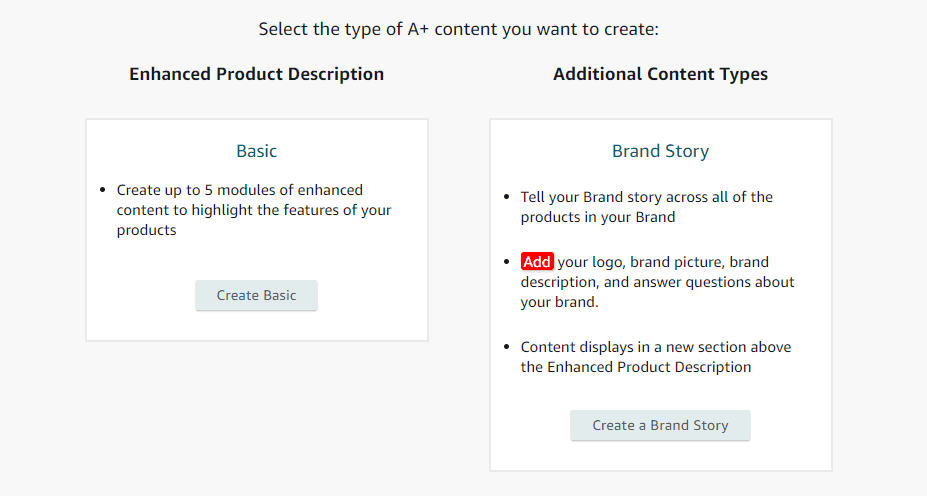
Source: Amazon
Eligibility criteria
Brand Story is available to all sellers registered in the Amazon brand registry program. Whether or not you want to use the brand story feature, sellers are encouraged to join the brand registry program as it offers advanced tools to protect and present your brand on Amazon.
Where does the brand story appear?
The brand story appears right above your A+ Content in a dedicated section called "From The Brand," making it highly visible to the shoppers who scroll down to read the reviews or view A+ Content.
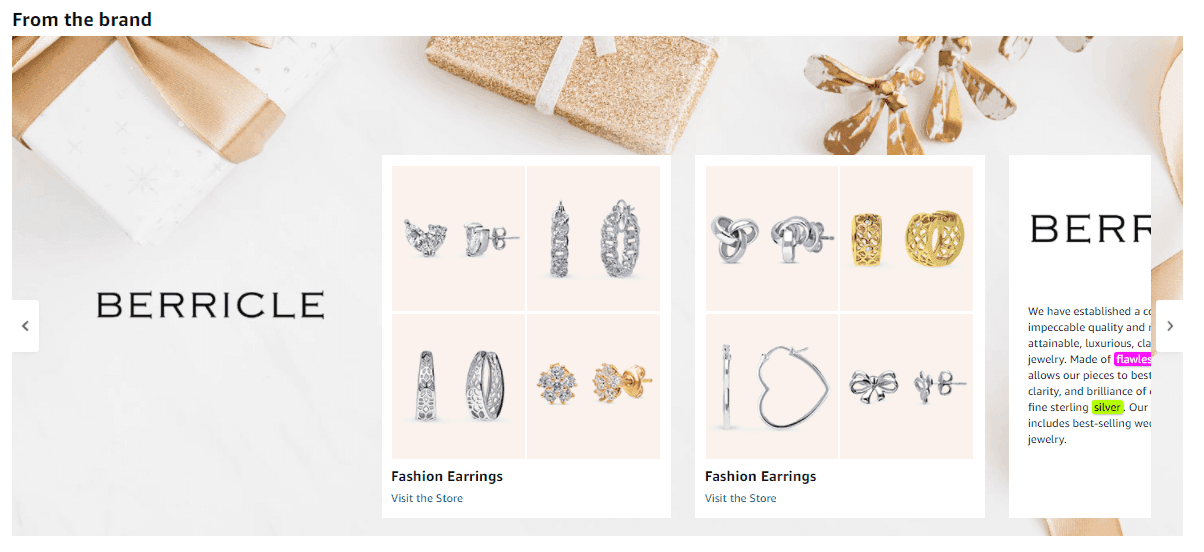
Source: Amazon
Understanding updated brand story modules
#1: Brand carousel background module
This is a mandatory module where you need to add a background image/hero image. You have the option to add a headline text and body text. We recommend adding a clean background image that blends in seamlessly while other images are cycling through.
Specifications:
Background image size: 1464 x 625 pixels / 463 x 625 pixels
Headline text character limit: 30 characters
Body text character limit: 135 characters
Tip:
We recommend that your background image guide shoppers to scroll further (see the image below) because, unlike desktops, on smaller screens, shoppers will have to scroll to see the first module.
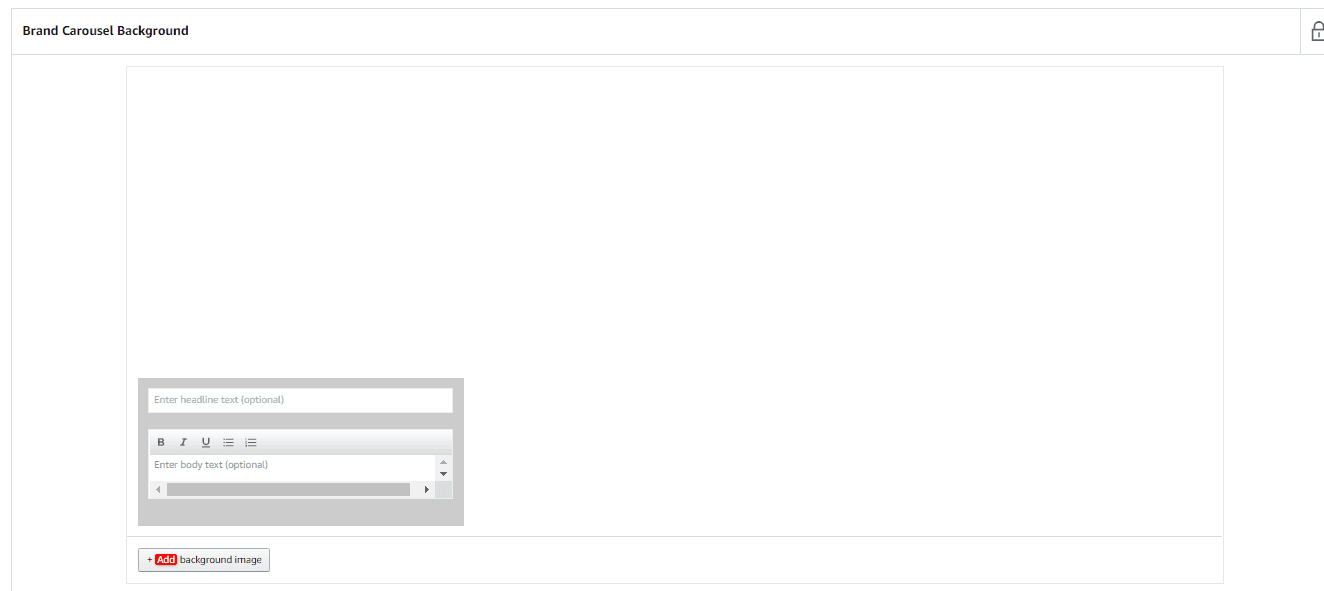
Source: Amazon
#2: Brand ASIN & Store Showcase module
Clicking on this module will redirect customers to your product detail pages or Amazon seller storefront. It works similarly to the comparison module of A+ Content. As this module is intended for cross-selling and increasing your average order value, we recommend you add a call-to-action like "view our collection"
or “Know more about our products.”
Specifications:
Image size: 166 x 182 pixels
Headline text character limit: 30 characters
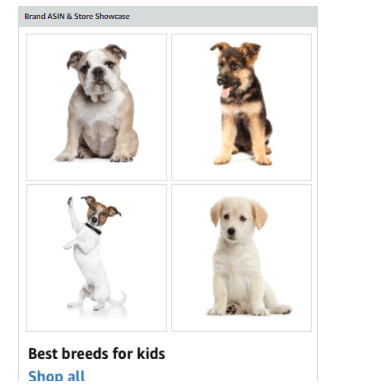
Source: Amazon
#3: Brand Focus Image module
This is a visual module where you can add an image of the brand's creator, an image that displays your product line, or any other image that defines our brand and aligns with your messaging.
Specifications:
Image size: 362 x 453 pixel
Headline text character limit: 30 characters
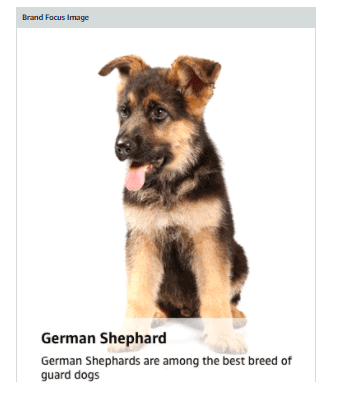
Source: Amazon
#4: Brand Logo & Description module
As the name suggests, you can add your brand logo and a short description of your brand. This is a great place to highlight your vision, mission, story, ethics, values, or something similar.
Specifications:
Image size: 315 x 145 pixels
Body text character limit: 450 characters
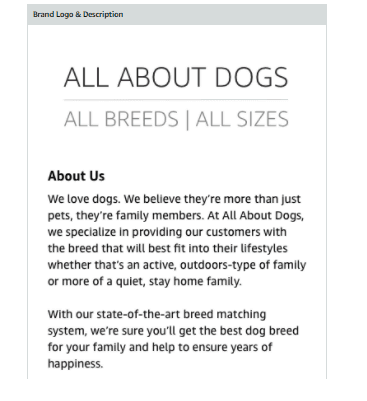
Source: Amazon
#5: Brand Q & A module
You can choose from three pre-set questions or add custom questions. This module helps address commonly asked questions about your brand or products.
Specifications:
The combined character limit for all questions: 750 characters
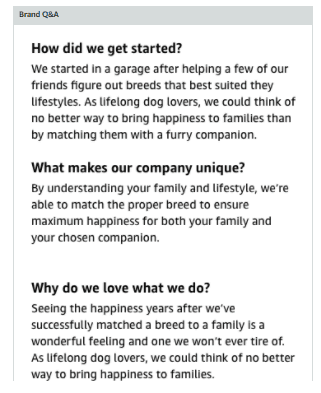
Source: Amazon
How to add a brand story to your listing?
Step 1: Locate the Advertising tab and click A+ Content Manager from the dropdown.
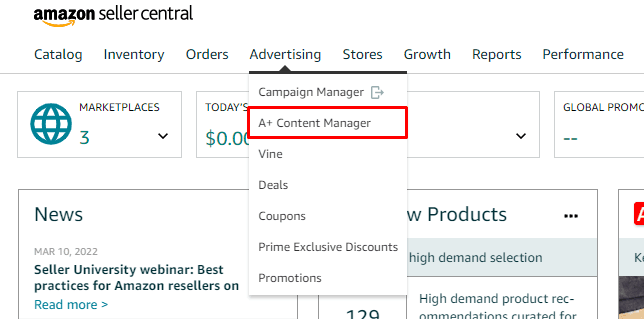
Step 2: Click on Start creating A+ Content.

Step 3: Click on Create a Brand Story.

Step 4: Add content name and language.
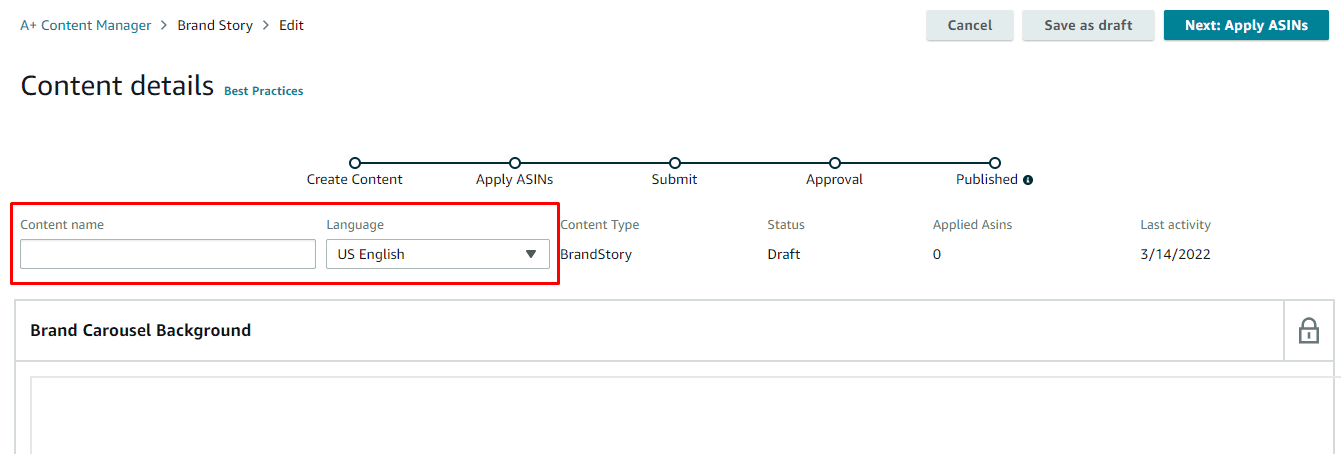
Step 5: Add your background image and text.
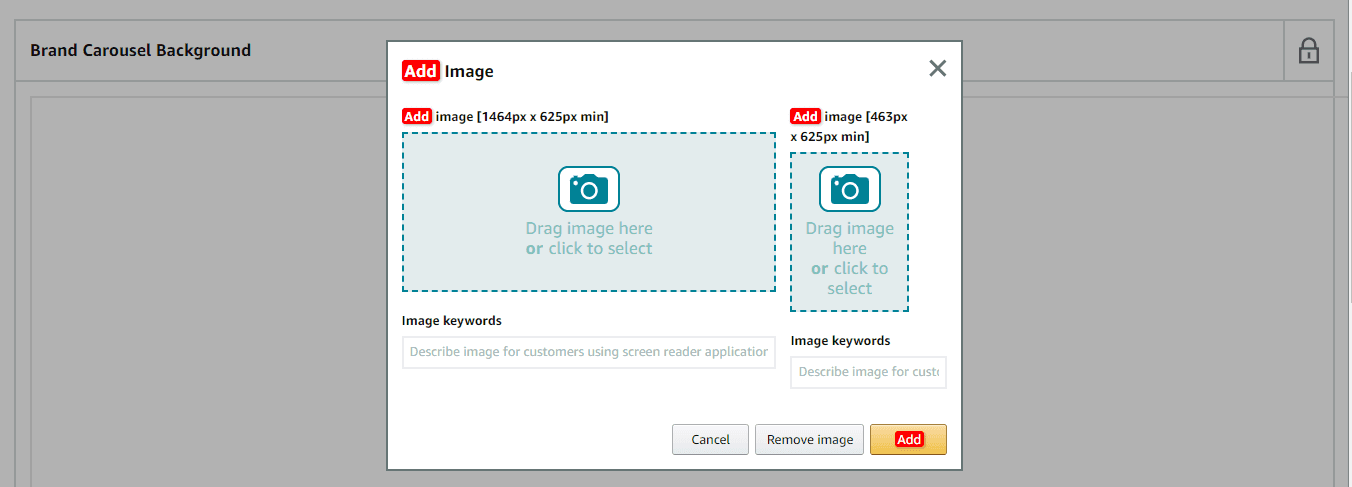
Step 6: Click on the Add Module button and start adding modules.
Step 7: Select the ASINs you would like to add. If you would like your brand story to appear on all the ASINs within your brand, choose the "bulk upload" feature.
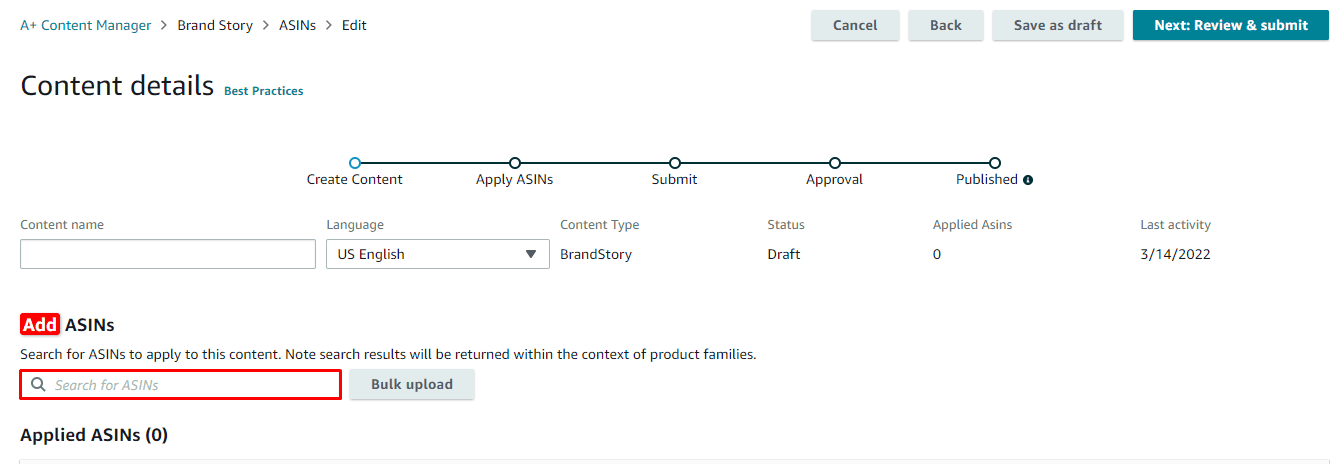
Step 8: Click on Review and Submit.
It might take up to 24 hours for Amazon to review your brand story before going live on the detail page.
Tips for writing a successful brand story

What a brand story is?
The brand story weaves together your brand's values, emotions, and ethics. It shows the complete picture of your brand, narrates the motivation for starting your business, and evokes an emotional response. A great brand story keeps your brand grounded while also giving it wings to fly and soar. When created the right way, it gives shoppers a reason to buy from you.
What a brand story is not?
A brand story is not your personal story or a sales pitch.
Your brand story should answer the following questions:
What do you do?
Why you do?
How you do?
#1: Create a narrative that positions your brand as relatable
People buy from people they relate to. Your shoppers will forget logos, they'll forget your reviews, they'll forget what you wrote, but they will always remember your story and how it made them feel. By pulling back the curtain and showcasing your brand story, you're humanizing your brand, making it easier for people to relate to you. Do not focus on corporate storytelling; cultivate a more authentic relationship that helps shoppers align with your core values.
#2: Keep it real
Let the face behind the brand shine through. In today's fast-paced world, human touch is getting increasingly coveted. You can no longer afford to be a faceless entity. To stay in the competition, brands must build heart-to-heart connections with the shoppers and engage with them at a more personal level. Your brand story must include your brand's history, struggles, and value proposition. The better you communicate these things, the easier it is to engage with the shoppers and build valuable relationships.
#3: Keep it simple
Your brand story should focus on the problem, solution, and success. Most stories have a beginning that usually narrates why you started your brand in the first place, then a struggle and an end. Always remember to keep your story simple and to the point, or you might end up losing the customer. Simple stories build trust and keep the shoppers glued.
#4: Communicate the purpose of the brand
Your brand should always include the "why." Your brand isn't just about making money. What motivated you to build a brand? Are you improving the shopper's life in any way? Every product, business, and brand is built to make customer's lives easier. To make sure your brand story leaves a mark, communicate the purpose and create a reason for them to buy from you.
#5: Build an emotional connection with the shoppers
Storytelling is all about connecting with the shoppers at an emotional stage. It is also 22 times more memorable than facts. Instead of throwing stats and reviews at your shoppers, make your brand memorable with an honest and transparent brand story. Wrap your brand values, ethics, and message into a story that provokes an emotional response.
#6: Build a tribe
Ask yourself, how do you want your shoppers to feel while they interact with your brand or use your products? Red Bull, for example, has built a tribe of die-hard, eye-popping energy drink lovers and sports enthusiasts. Apple has created a tribe of shoppers who are absolutely in awe of their "Apple" devices and can't stop showing off their devices. Building a loyal tribe of customers will pay off because they'll follow along, support your success, and keep on coming back for more.
#7: Paint customers as the hero of your story
Miller, in his book Building a StoryBrand, said, "The fact is, pretty websites don't sell things. Words sell things. And if we haven't clarified our message, our customers won't listen." Apple, for example, has loads of features like abundant drive space, super-fast processing, a gorgeous retina display, and more. But their ads will show what it is like to be a proud owner of an iPhone or a MacBook. Customers are the main character and that's why their marketing campaigns are always a hit.
Pros of Amazon brand story
#1: The Brand ASIN and Store Showcase module lets you upsell other products from your brand.
#2: Brand Story serves as a way to introduce other products from your portfolio.
#3: The organized layout offers a clean look.
#4: Carousel display allows you to present information in a visually pleasing and easy-to-navigate way.
#5: You can add up to 19 modules. This is a lot more than what you can add to your Enhanced Brand Content.
Cons of Amazon brand story
The only two limitations of the brand story we could find were:
#1: It pushes A+ Content further down the detail page.
#2: It isn’t completely mobile friendly.
Is the brand story worth it?
Yes, it is and we have three reasons to prove it:
Reason #1: It sells better
Harvard Business School professor Gerald Zaltman says that 95% of our purchase decisions are taken subconsciously. We buy on emotion and justify our purchase with logic. If this is true, emotions are the real star of purchase decision-making. Your Amazon detail page is packed with information, facts, figures, and testimonials. All this data floods customers with too much information and results in paralysis for analysis. We are not saying writing an informative copy is unimportant. But the brand story connects with the emotional side of the shoppers, the side responsible for making a purchase decision.
Reason #2: It builds a connection
We are genetically wired to love stories. According to Paul Zak's research, our brains produce the stress hormone cortisol during tense moments in storytelling, allowing us to focus on the story. When the tension ends, our brains release the feel-good hormone oxytocin that forges connection and empathy. A brand story combines tension and ends with a feel-good moment, thus helping shoppers connect with your brand at a different level.
Reason #3: It gives you more real estate on the detail page
These days, product detail pages are jam-packed with Sponsored Ads. Competitor listings are spread everywhere across the detail page, ready to steal your shoppers away. This is why your content (visual or text-based) must take as much space as possible on the detail page. If you already have A+ Content, a brand story is one of the best ways to claim more real estate on the detail page. Even if you're on the fence about adding a brand story to your listing, just ask yourself, would you like to have a carousel of images highlighting your brand story or a carousel of ads that may take shoppers away from your product detail page?
Examples of Amazon brand story
#1: Flavor God

Source: Amazon
#2: BERRICLE
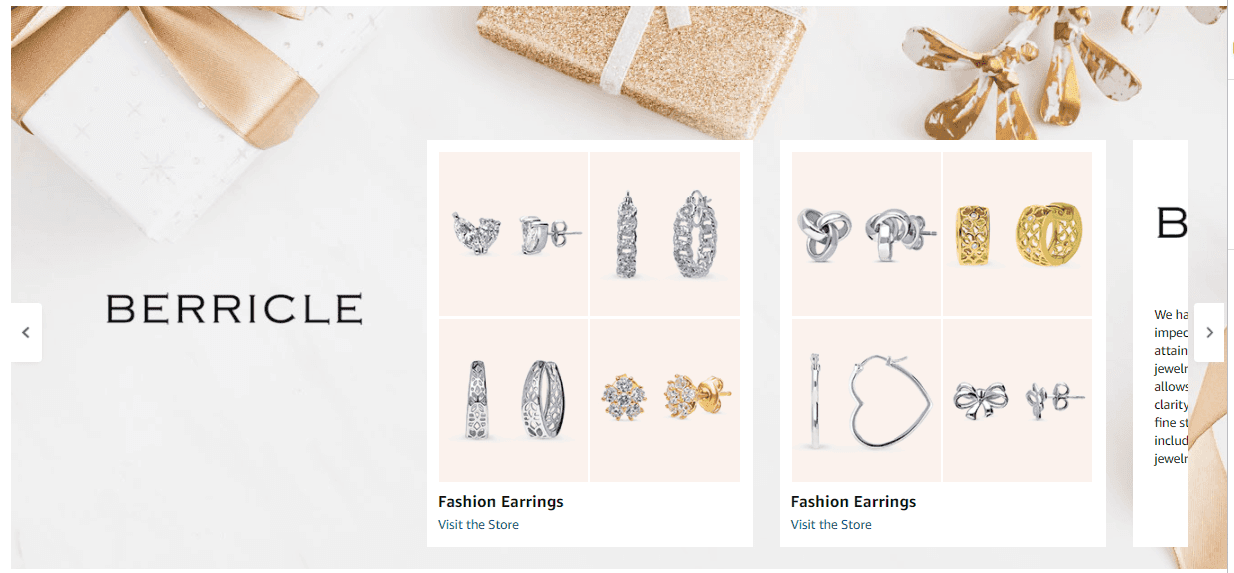
Source: Amazon
#3: TOPGRILLZ
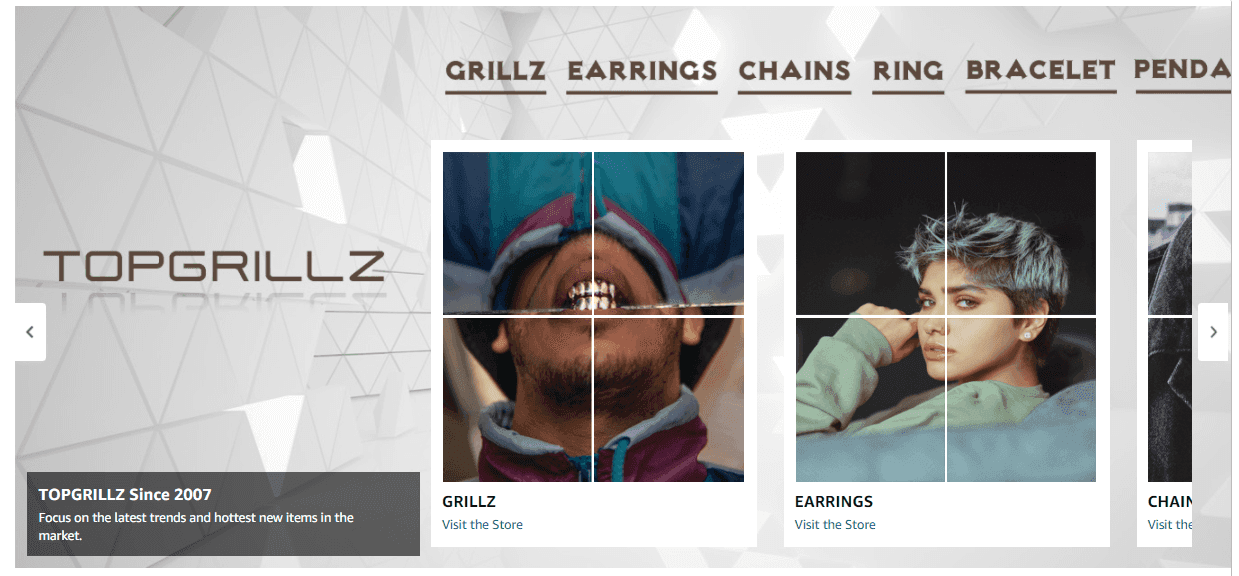
Source: Amazon
#4: Vital Proteins
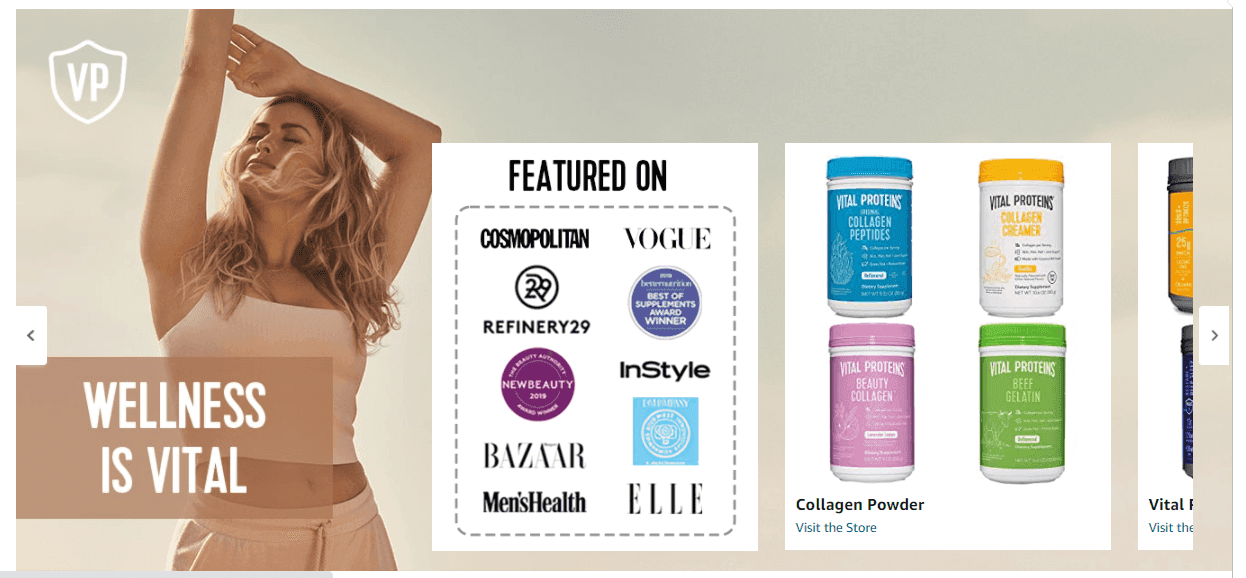
Source: Amazon
#5: Bedsure
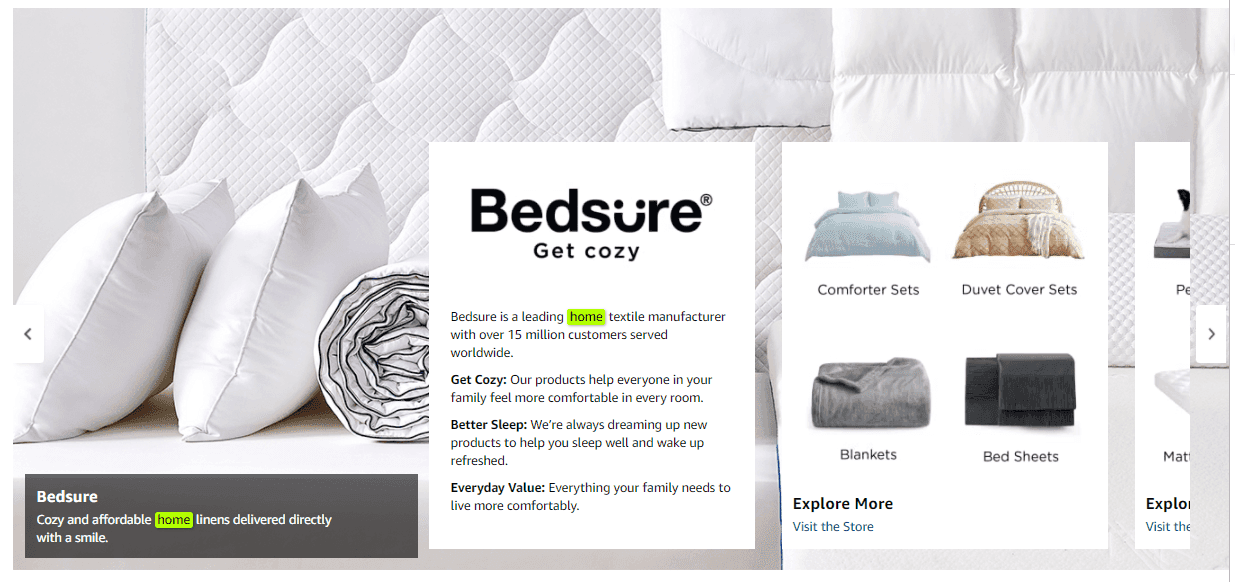
Source: Amazon
Brand story is no longer nice to have; it is a must-have.
Despite the cons, the brand story helps brands become less anonymous and connect on an emotional level with their customers. Overall, it is truly a valuable tool and worth testing. Just like A+ Content, it is constantly evolving and Amazon will continue to expand its functionality in the coming years. Our Amazon consulting experts have been helping sellers create a brand story for their listing since it first launched in 2020. If you need help launching your brand story or improving your existing brand story, we'll be happy to help.
"In the sea of sameness, be unique with Amazon brand story"
Amazon is a crowded marketplace. Sellers spend hundreds of dollars fighting for seconds of attention. Shoppers are bombarded with similar copies, messages, and images every minute of their shopping journey. It is not enough for brands to have a quality product, optimized listing, and competitive price. Everyone has that. One of the key ways to keep your brand on top of customers' minds is by conveying your brand story. Brand story is what differentiates you from the crowd and at the same time makes your brand more relatable and humanized.
In September 2021, Amazon updated its Brand Story feature and introduced new and interesting modules that will help brands highlight their critical elements. In this article, we’ll review the basics of Amazon's brand story, learn about the new modules, and find tips for writing a successful brand story.
What is the Amazon brand story?
Positioned right above the A+ Content, Brand Story is available as a scrollable carousel where brand-registered sellers can portray their brand values, ethics, mission, vision, people, and the process behind making products while also highlighting their product catalog and brand store.
When the brand story was first introduced, there was a fixed template where sellers could only add two images and answer three predefined questions (how you got your start, what makes your products unique, and why you love what you do). Last year, Amazon introduced new modules and even introduced the functionality of linking brand stories to your brand store and other product detail pages.

Source: Amazon
Eligibility criteria
Brand Story is available to all sellers registered in the Amazon brand registry program. Whether or not you want to use the brand story feature, sellers are encouraged to join the brand registry program as it offers advanced tools to protect and present your brand on Amazon.
Where does the brand story appear?
The brand story appears right above your A+ Content in a dedicated section called "From The Brand," making it highly visible to the shoppers who scroll down to read the reviews or view A+ Content.

Source: Amazon
Understanding updated brand story modules
#1: Brand carousel background module
This is a mandatory module where you need to add a background image/hero image. You have the option to add a headline text and body text. We recommend adding a clean background image that blends in seamlessly while other images are cycling through.
Specifications:
Background image size: 1464 x 625 pixels / 463 x 625 pixels
Headline text character limit: 30 characters
Body text character limit: 135 characters
Tip:
We recommend that your background image guide shoppers to scroll further (see the image below) because, unlike desktops, on smaller screens, shoppers will have to scroll to see the first module.

Source: Amazon
#2: Brand ASIN & Store Showcase module
Clicking on this module will redirect customers to your product detail pages or Amazon seller storefront. It works similarly to the comparison module of A+ Content. As this module is intended for cross-selling and increasing your average order value, we recommend you add a call-to-action like "view our collection"
or “Know more about our products.”
Specifications:
Image size: 166 x 182 pixels
Headline text character limit: 30 characters

Source: Amazon
#3: Brand Focus Image module
This is a visual module where you can add an image of the brand's creator, an image that displays your product line, or any other image that defines our brand and aligns with your messaging.
Specifications:
Image size: 362 x 453 pixel
Headline text character limit: 30 characters

Source: Amazon
#4: Brand Logo & Description module
As the name suggests, you can add your brand logo and a short description of your brand. This is a great place to highlight your vision, mission, story, ethics, values, or something similar.
Specifications:
Image size: 315 x 145 pixels
Body text character limit: 450 characters

Source: Amazon
#5: Brand Q & A module
You can choose from three pre-set questions or add custom questions. This module helps address commonly asked questions about your brand or products.
Specifications:
The combined character limit for all questions: 750 characters

Source: Amazon
How to add a brand story to your listing?
Step 1: Locate the Advertising tab and click A+ Content Manager from the dropdown.

Step 2: Click on Start creating A+ Content.

Step 3: Click on Create a Brand Story.

Step 4: Add content name and language.

Step 5: Add your background image and text.

Step 6: Click on the Add Module button and start adding modules.
Step 7: Select the ASINs you would like to add. If you would like your brand story to appear on all the ASINs within your brand, choose the "bulk upload" feature.

Step 8: Click on Review and Submit.
It might take up to 24 hours for Amazon to review your brand story before going live on the detail page.
Tips for writing a successful brand story

What a brand story is?
The brand story weaves together your brand's values, emotions, and ethics. It shows the complete picture of your brand, narrates the motivation for starting your business, and evokes an emotional response. A great brand story keeps your brand grounded while also giving it wings to fly and soar. When created the right way, it gives shoppers a reason to buy from you.
What a brand story is not?
A brand story is not your personal story or a sales pitch.
Your brand story should answer the following questions:
What do you do?
Why you do?
How you do?
#1: Create a narrative that positions your brand as relatable
People buy from people they relate to. Your shoppers will forget logos, they'll forget your reviews, they'll forget what you wrote, but they will always remember your story and how it made them feel. By pulling back the curtain and showcasing your brand story, you're humanizing your brand, making it easier for people to relate to you. Do not focus on corporate storytelling; cultivate a more authentic relationship that helps shoppers align with your core values.
#2: Keep it real
Let the face behind the brand shine through. In today's fast-paced world, human touch is getting increasingly coveted. You can no longer afford to be a faceless entity. To stay in the competition, brands must build heart-to-heart connections with the shoppers and engage with them at a more personal level. Your brand story must include your brand's history, struggles, and value proposition. The better you communicate these things, the easier it is to engage with the shoppers and build valuable relationships.
#3: Keep it simple
Your brand story should focus on the problem, solution, and success. Most stories have a beginning that usually narrates why you started your brand in the first place, then a struggle and an end. Always remember to keep your story simple and to the point, or you might end up losing the customer. Simple stories build trust and keep the shoppers glued.
#4: Communicate the purpose of the brand
Your brand should always include the "why." Your brand isn't just about making money. What motivated you to build a brand? Are you improving the shopper's life in any way? Every product, business, and brand is built to make customer's lives easier. To make sure your brand story leaves a mark, communicate the purpose and create a reason for them to buy from you.
#5: Build an emotional connection with the shoppers
Storytelling is all about connecting with the shoppers at an emotional stage. It is also 22 times more memorable than facts. Instead of throwing stats and reviews at your shoppers, make your brand memorable with an honest and transparent brand story. Wrap your brand values, ethics, and message into a story that provokes an emotional response.
#6: Build a tribe
Ask yourself, how do you want your shoppers to feel while they interact with your brand or use your products? Red Bull, for example, has built a tribe of die-hard, eye-popping energy drink lovers and sports enthusiasts. Apple has created a tribe of shoppers who are absolutely in awe of their "Apple" devices and can't stop showing off their devices. Building a loyal tribe of customers will pay off because they'll follow along, support your success, and keep on coming back for more.
#7: Paint customers as the hero of your story
Miller, in his book Building a StoryBrand, said, "The fact is, pretty websites don't sell things. Words sell things. And if we haven't clarified our message, our customers won't listen." Apple, for example, has loads of features like abundant drive space, super-fast processing, a gorgeous retina display, and more. But their ads will show what it is like to be a proud owner of an iPhone or a MacBook. Customers are the main character and that's why their marketing campaigns are always a hit.
Pros of Amazon brand story
#1: The Brand ASIN and Store Showcase module lets you upsell other products from your brand.
#2: Brand Story serves as a way to introduce other products from your portfolio.
#3: The organized layout offers a clean look.
#4: Carousel display allows you to present information in a visually pleasing and easy-to-navigate way.
#5: You can add up to 19 modules. This is a lot more than what you can add to your Enhanced Brand Content.
Cons of Amazon brand story
The only two limitations of the brand story we could find were:
#1: It pushes A+ Content further down the detail page.
#2: It isn’t completely mobile friendly.
Is the brand story worth it?
Yes, it is and we have three reasons to prove it:
Reason #1: It sells better
Harvard Business School professor Gerald Zaltman says that 95% of our purchase decisions are taken subconsciously. We buy on emotion and justify our purchase with logic. If this is true, emotions are the real star of purchase decision-making. Your Amazon detail page is packed with information, facts, figures, and testimonials. All this data floods customers with too much information and results in paralysis for analysis. We are not saying writing an informative copy is unimportant. But the brand story connects with the emotional side of the shoppers, the side responsible for making a purchase decision.
Reason #2: It builds a connection
We are genetically wired to love stories. According to Paul Zak's research, our brains produce the stress hormone cortisol during tense moments in storytelling, allowing us to focus on the story. When the tension ends, our brains release the feel-good hormone oxytocin that forges connection and empathy. A brand story combines tension and ends with a feel-good moment, thus helping shoppers connect with your brand at a different level.
Reason #3: It gives you more real estate on the detail page
These days, product detail pages are jam-packed with Sponsored Ads. Competitor listings are spread everywhere across the detail page, ready to steal your shoppers away. This is why your content (visual or text-based) must take as much space as possible on the detail page. If you already have A+ Content, a brand story is one of the best ways to claim more real estate on the detail page. Even if you're on the fence about adding a brand story to your listing, just ask yourself, would you like to have a carousel of images highlighting your brand story or a carousel of ads that may take shoppers away from your product detail page?
Examples of Amazon brand story
#1: Flavor God

Source: Amazon
#2: BERRICLE

Source: Amazon
#3: TOPGRILLZ

Source: Amazon
#4: Vital Proteins

Source: Amazon
#5: Bedsure

Source: Amazon
Brand story is no longer nice to have; it is a must-have.
Despite the cons, the brand story helps brands become less anonymous and connect on an emotional level with their customers. Overall, it is truly a valuable tool and worth testing. Just like A+ Content, it is constantly evolving and Amazon will continue to expand its functionality in the coming years. Our Amazon consulting experts have been helping sellers create a brand story for their listing since it first launched in 2020. If you need help launching your brand story or improving your existing brand story, we'll be happy to help.
"In the sea of sameness, be unique with Amazon brand story"
Amazon is a crowded marketplace. Sellers spend hundreds of dollars fighting for seconds of attention. Shoppers are bombarded with similar copies, messages, and images every minute of their shopping journey. It is not enough for brands to have a quality product, optimized listing, and competitive price. Everyone has that. One of the key ways to keep your brand on top of customers' minds is by conveying your brand story. Brand story is what differentiates you from the crowd and at the same time makes your brand more relatable and humanized.
In September 2021, Amazon updated its Brand Story feature and introduced new and interesting modules that will help brands highlight their critical elements. In this article, we’ll review the basics of Amazon's brand story, learn about the new modules, and find tips for writing a successful brand story.
What is the Amazon brand story?
Positioned right above the A+ Content, Brand Story is available as a scrollable carousel where brand-registered sellers can portray their brand values, ethics, mission, vision, people, and the process behind making products while also highlighting their product catalog and brand store.
When the brand story was first introduced, there was a fixed template where sellers could only add two images and answer three predefined questions (how you got your start, what makes your products unique, and why you love what you do). Last year, Amazon introduced new modules and even introduced the functionality of linking brand stories to your brand store and other product detail pages.

Source: Amazon
Eligibility criteria
Brand Story is available to all sellers registered in the Amazon brand registry program. Whether or not you want to use the brand story feature, sellers are encouraged to join the brand registry program as it offers advanced tools to protect and present your brand on Amazon.
Where does the brand story appear?
The brand story appears right above your A+ Content in a dedicated section called "From The Brand," making it highly visible to the shoppers who scroll down to read the reviews or view A+ Content.

Source: Amazon
Understanding updated brand story modules
#1: Brand carousel background module
This is a mandatory module where you need to add a background image/hero image. You have the option to add a headline text and body text. We recommend adding a clean background image that blends in seamlessly while other images are cycling through.
Specifications:
Background image size: 1464 x 625 pixels / 463 x 625 pixels
Headline text character limit: 30 characters
Body text character limit: 135 characters
Tip:
We recommend that your background image guide shoppers to scroll further (see the image below) because, unlike desktops, on smaller screens, shoppers will have to scroll to see the first module.

Source: Amazon
#2: Brand ASIN & Store Showcase module
Clicking on this module will redirect customers to your product detail pages or Amazon seller storefront. It works similarly to the comparison module of A+ Content. As this module is intended for cross-selling and increasing your average order value, we recommend you add a call-to-action like "view our collection"
or “Know more about our products.”
Specifications:
Image size: 166 x 182 pixels
Headline text character limit: 30 characters

Source: Amazon
#3: Brand Focus Image module
This is a visual module where you can add an image of the brand's creator, an image that displays your product line, or any other image that defines our brand and aligns with your messaging.
Specifications:
Image size: 362 x 453 pixel
Headline text character limit: 30 characters

Source: Amazon
#4: Brand Logo & Description module
As the name suggests, you can add your brand logo and a short description of your brand. This is a great place to highlight your vision, mission, story, ethics, values, or something similar.
Specifications:
Image size: 315 x 145 pixels
Body text character limit: 450 characters

Source: Amazon
#5: Brand Q & A module
You can choose from three pre-set questions or add custom questions. This module helps address commonly asked questions about your brand or products.
Specifications:
The combined character limit for all questions: 750 characters

Source: Amazon
How to add a brand story to your listing?
Step 1: Locate the Advertising tab and click A+ Content Manager from the dropdown.

Step 2: Click on Start creating A+ Content.

Step 3: Click on Create a Brand Story.

Step 4: Add content name and language.

Step 5: Add your background image and text.

Step 6: Click on the Add Module button and start adding modules.
Step 7: Select the ASINs you would like to add. If you would like your brand story to appear on all the ASINs within your brand, choose the "bulk upload" feature.

Step 8: Click on Review and Submit.
It might take up to 24 hours for Amazon to review your brand story before going live on the detail page.
Tips for writing a successful brand story

What a brand story is?
The brand story weaves together your brand's values, emotions, and ethics. It shows the complete picture of your brand, narrates the motivation for starting your business, and evokes an emotional response. A great brand story keeps your brand grounded while also giving it wings to fly and soar. When created the right way, it gives shoppers a reason to buy from you.
What a brand story is not?
A brand story is not your personal story or a sales pitch.
Your brand story should answer the following questions:
What do you do?
Why you do?
How you do?
#1: Create a narrative that positions your brand as relatable
People buy from people they relate to. Your shoppers will forget logos, they'll forget your reviews, they'll forget what you wrote, but they will always remember your story and how it made them feel. By pulling back the curtain and showcasing your brand story, you're humanizing your brand, making it easier for people to relate to you. Do not focus on corporate storytelling; cultivate a more authentic relationship that helps shoppers align with your core values.
#2: Keep it real
Let the face behind the brand shine through. In today's fast-paced world, human touch is getting increasingly coveted. You can no longer afford to be a faceless entity. To stay in the competition, brands must build heart-to-heart connections with the shoppers and engage with them at a more personal level. Your brand story must include your brand's history, struggles, and value proposition. The better you communicate these things, the easier it is to engage with the shoppers and build valuable relationships.
#3: Keep it simple
Your brand story should focus on the problem, solution, and success. Most stories have a beginning that usually narrates why you started your brand in the first place, then a struggle and an end. Always remember to keep your story simple and to the point, or you might end up losing the customer. Simple stories build trust and keep the shoppers glued.
#4: Communicate the purpose of the brand
Your brand should always include the "why." Your brand isn't just about making money. What motivated you to build a brand? Are you improving the shopper's life in any way? Every product, business, and brand is built to make customer's lives easier. To make sure your brand story leaves a mark, communicate the purpose and create a reason for them to buy from you.
#5: Build an emotional connection with the shoppers
Storytelling is all about connecting with the shoppers at an emotional stage. It is also 22 times more memorable than facts. Instead of throwing stats and reviews at your shoppers, make your brand memorable with an honest and transparent brand story. Wrap your brand values, ethics, and message into a story that provokes an emotional response.
#6: Build a tribe
Ask yourself, how do you want your shoppers to feel while they interact with your brand or use your products? Red Bull, for example, has built a tribe of die-hard, eye-popping energy drink lovers and sports enthusiasts. Apple has created a tribe of shoppers who are absolutely in awe of their "Apple" devices and can't stop showing off their devices. Building a loyal tribe of customers will pay off because they'll follow along, support your success, and keep on coming back for more.
#7: Paint customers as the hero of your story
Miller, in his book Building a StoryBrand, said, "The fact is, pretty websites don't sell things. Words sell things. And if we haven't clarified our message, our customers won't listen." Apple, for example, has loads of features like abundant drive space, super-fast processing, a gorgeous retina display, and more. But their ads will show what it is like to be a proud owner of an iPhone or a MacBook. Customers are the main character and that's why their marketing campaigns are always a hit.
Pros of Amazon brand story
#1: The Brand ASIN and Store Showcase module lets you upsell other products from your brand.
#2: Brand Story serves as a way to introduce other products from your portfolio.
#3: The organized layout offers a clean look.
#4: Carousel display allows you to present information in a visually pleasing and easy-to-navigate way.
#5: You can add up to 19 modules. This is a lot more than what you can add to your Enhanced Brand Content.
Cons of Amazon brand story
The only two limitations of the brand story we could find were:
#1: It pushes A+ Content further down the detail page.
#2: It isn’t completely mobile friendly.
Is the brand story worth it?
Yes, it is and we have three reasons to prove it:
Reason #1: It sells better
Harvard Business School professor Gerald Zaltman says that 95% of our purchase decisions are taken subconsciously. We buy on emotion and justify our purchase with logic. If this is true, emotions are the real star of purchase decision-making. Your Amazon detail page is packed with information, facts, figures, and testimonials. All this data floods customers with too much information and results in paralysis for analysis. We are not saying writing an informative copy is unimportant. But the brand story connects with the emotional side of the shoppers, the side responsible for making a purchase decision.
Reason #2: It builds a connection
We are genetically wired to love stories. According to Paul Zak's research, our brains produce the stress hormone cortisol during tense moments in storytelling, allowing us to focus on the story. When the tension ends, our brains release the feel-good hormone oxytocin that forges connection and empathy. A brand story combines tension and ends with a feel-good moment, thus helping shoppers connect with your brand at a different level.
Reason #3: It gives you more real estate on the detail page
These days, product detail pages are jam-packed with Sponsored Ads. Competitor listings are spread everywhere across the detail page, ready to steal your shoppers away. This is why your content (visual or text-based) must take as much space as possible on the detail page. If you already have A+ Content, a brand story is one of the best ways to claim more real estate on the detail page. Even if you're on the fence about adding a brand story to your listing, just ask yourself, would you like to have a carousel of images highlighting your brand story or a carousel of ads that may take shoppers away from your product detail page?
Examples of Amazon brand story
#1: Flavor God

Source: Amazon
#2: BERRICLE

Source: Amazon
#3: TOPGRILLZ

Source: Amazon
#4: Vital Proteins

Source: Amazon
#5: Bedsure

Source: Amazon
Brand story is no longer nice to have; it is a must-have.
Despite the cons, the brand story helps brands become less anonymous and connect on an emotional level with their customers. Overall, it is truly a valuable tool and worth testing. Just like A+ Content, it is constantly evolving and Amazon will continue to expand its functionality in the coming years. Our Amazon consulting experts have been helping sellers create a brand story for their listing since it first launched in 2020. If you need help launching your brand story or improving your existing brand story, we'll be happy to help.






